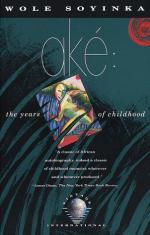
|
| Name: _________________________ | Period: ___________________ |
This test consists of 15 multiple choice questions and 5 short answer questions.
Multiple Choice Questions
1. What inspires Kemberi to give a speech in Chapter 13?
(a) A woman was raped by a policeman.
(b) Women were forced to pay exorbitant taxes on goods.
(c) A mudslide had caused sanitation problems in the town.
(d) A young orphan died from starvation.
2. Why does Wole receive lashings in Chapter 12?
(a) For stabbing a student with a pencil.
(b) For sloppy grass-cutting.
(c) For stealing school supplies.
(d) For not properly cleaning the blackboards.
3. What does Essay make Wole promise him in Chapter 11?
(a) That Wole will attend college.
(b) That Wole will travel to America.
(c) That Wole will never lie again.
(d) That Wole will always attend church.
4. Where does Sorowanke live, according to Chapter 10?
(a) The parking lot of a McDonald's.
(b) In a shanty town by the river.
(c) Mr. B's house.
(d) Dayisi's Walk.
5. What form does the ghommid take when it chases Uncle Sanya in Chapter 1?
(a) A storm cloud.
(b) A giant fireball.
(c) The Devil.
(d) An ogre.
6. What is akara?
(a) Fried bean cake.
(b) A salve used to treat bee stings.
(c) A spirit of the forest.
(d) A process of application to become a holy man.
7. At the end of Chapter 10, what is the status of Sorowanke?
(a) She settles down and raises a family.
(b) She becomes the owner of a successful coconut cake shop.
(c) She is driven from the town and forgotten.
(d) She is driven from the town, but the city elders record her tale for posterity.
8. What is tinko?
(a) Lean meat fried to a hard crisp.
(b) Pennies for church tithe.
(c) A small truck used to transport villagers.
(d) Tinsel wrapping for gifts.
9. What best characterizes Wee-Wee's handling of the grammar school?
(a) Lenient.
(b) Admirable.
(c) Uncertain.
(d) Corrupt.
10. What positive omen takes place during the protest at the end of Chapter 14?
(a) A soothsayer reports the spirits are pleased.
(b) It rains.
(c) A cow joins the crowd.
(d) A baby girl is born.
11. What does Wild Christian name her women's group?
(a) The Egba Women's Union.
(b) The Ake Women's Collective.
(c) Many Voices, One Voice.
(d) Women's Advocacy Organization.
12. How is Beere received when she returns from England?
(a) She is given an award from the local governor.
(b) She is reviled, and fruit is thrown at her.
(c) She is given a hero's welcome.
(d) The return happens without incident.
13. In Chapter 9 after a fight with a snake, what part of the snake does Broda Pupa bury?
(a) The entire snake.
(b) He refuses to bury the snake.
(c) The head.
(d) The rattle.
14. What secret promise does Beere make with Wole at the end of the book?
(a) Beere will send Wole packages of his favorite food -- pounded yams.
(b) Beere will get Wole shoes.
(c) Beere will send Wole additional money.
(d) Beere will continue to give Wole news about the protest movement.
15. Why is Wole disappointed when he reaches Isara in Chapter 9?
(a) Isara is full of rich snobs who look down upon his family.
(b) The town is provincial and unsanitary.
(c) Wole does not receive any presents from Father.
(d) He was promised an elephant statue from a trader, but he never got it.
Short Answer Questions
1. How do the women mock the Alake at the beginning of Chapter 15?
2. What is the name of Sorowanke's boyfriend?
3. Why can't Wole attend Government College when he is initially accepted?
4. How does Wole react to the rite of manhood he endures in Chapter 9?
5. On a trip to Broda Pupa's farm, which is NOT one of the activities Wole participates in?
|
This section contains 662 words (approx. 3 pages at 300 words per page) |

|




